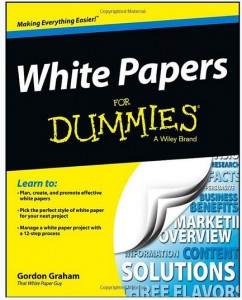 I just finished reading White Papers for Dummies. Yep, it’s one of those books—with a cover like caution tape you’d never want to be caught reading in public.
I just finished reading White Papers for Dummies. Yep, it’s one of those books—with a cover like caution tape you’d never want to be caught reading in public.
But I’m okay with that. This book might be for “dummies,” but it was written by the smartest guy in the white paper biz. Like the title of his book, the way Gordon Graham presents himself is totally straightforward: he’s “That White Paper Guy.”
And after reading the book, the moniker makes total sense. White papers often deal with complicated, highly technical subject matter. So the writer’s job, Graham says, is to make topics easy for readers (often, busy CEOs) to understand quickly. And that means speaking in plain language, designing pages for readability, and promoting white papers in places interested readers are likely to look.
What it’s all about
White Papers for Dummies begins with the basics of this often-misunderstood form. What is a white paper, anyway? According to Graham, it’s “a persuasive essay that uses facts and logic to promote a certain product, service, or solution to a problem.” White papers help B2B buyers get the lowdown on some product that’s new, complicated, or expensive (or all three). It’s not a sales pitch—instead, a white paper offers objective explanation of complex ideas.
Graham identifies the three most common structures, or “flavors” of white papers: the backgrounder, the problem/solution, and the numbered list—and what topics are best suited for each. He also offers a handy how-to for ensuring seamless white paper production, whether you’re a writer looking for work or a company in need of publicity for a new product.
Rules to follow, rules to break
I finished WPFD with a clear understanding of a writing format that once might as well have been Greek. But my favorite things about this book are the writing tips and tidbits Graham drops along the way. After 15 years in the business and nearly 200 white papers under his belt, That White Paper Guy has earned his title. He knows which techniques work—and which ones, frankly, suck.
For example, he says it’s okay not to be a social media addict. That it’s best to give up wordy, “throat-clearing” introductions and instead, get right to the point. And he says no to meaningless, mixed-up marketing speak:
“So what if you claim to have the ‘best-in-breed point solution for seamless integration with enterprise web 2.0 platforms’? Does all that jargon actually paint a clear picture of what you’re talking about? Not to most people. …This isn’t white paper writing; this is just blather and bafflegab.”
Marry me, White Paper Guy.
Graham also shares inspiration- and productivity-boosting tips, like the writing with the Pomodoro Technique, creating a “swipe file,” and using NaturalReader, plus hints for adding visual interest to white papers and thinking up an attention-grabbing title.
White paper writing is one of those rare niches where demand far exceeds supply, Gordon says. So it’s a huge opportunity for writers who have what it takes. If you’re not scared of research, can structure an argument, and are a killer project manager, white paper writing might just be for you.
And if you’re a total dummy, that’s okay, too—there’s a book for that.
Snag your copy of WPFD here. And learn more about That White Paper Guy’s work on his website.
Human-Centered Content Eclipses All Others
The images we chose to share our experience of the 2024 solar eclipse show us that human-centered stories are the most meaningful.

